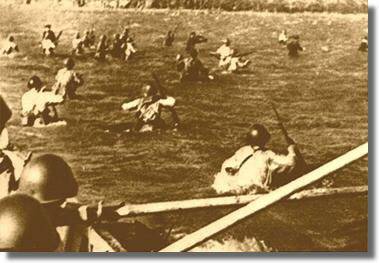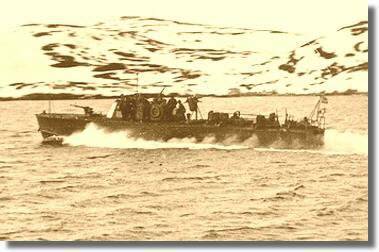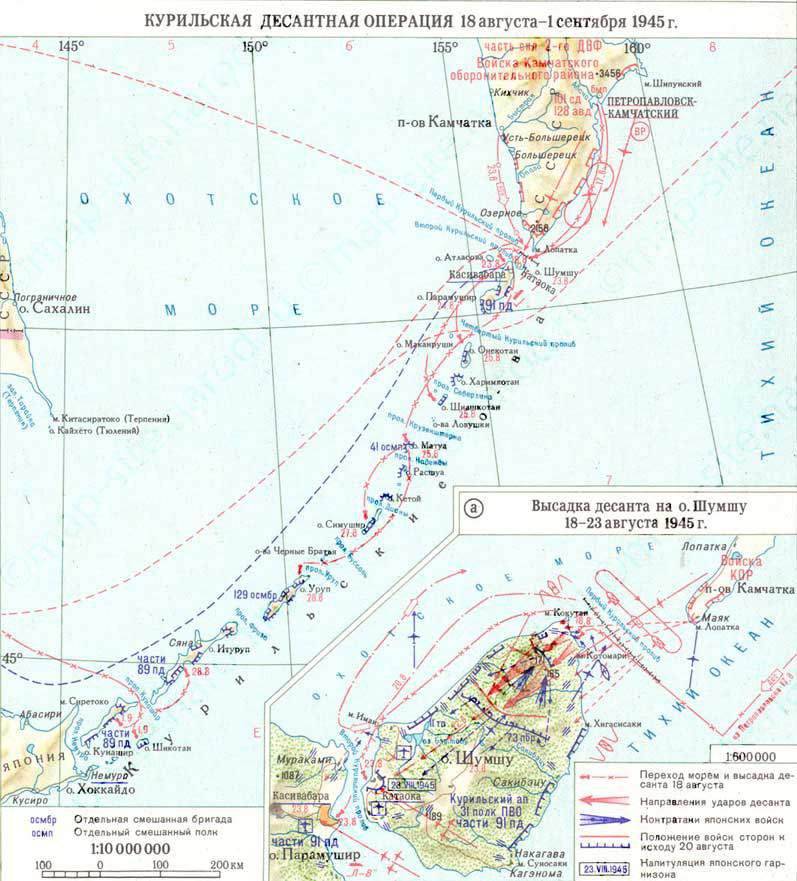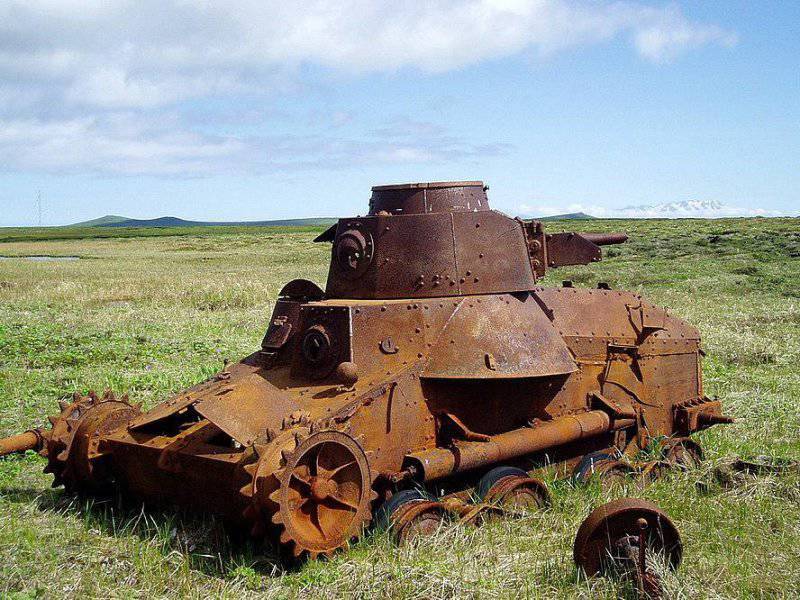The assault on the island of Shumshu in August 1945 of the year - the decisive moment of the Kuril landing operation
 Sturm Shumshu was a decisive event during the entire Kuril landing operation (August 18 - September 1 1945). The successful actions of the Soviet troops on Sakhalin Island (the South-Sakhalin operation) created favorable conditions for the liberation of the Kuriles. This was a very important geopolitical and strategic operation. The United States at this point agreed with the return to the Soviet Union of South Sakhalin and all the Kuril Islands. However, the delay could lead to the fact that the Kuriles, at least for a while, could be occupied by American troops. 15 August, the Japanese Emperor Hirohito announced the unconditional surrender of Japan. The troops were ordered to cease resistance and prepare for surrender - first of all to American troops. This option did not suit Moscow. In addition, the idea was to put the Americans before the fact - to land troops in Japan itself, in Hokkaido. But the path to Japan lay through the Kurils.
Sturm Shumshu was a decisive event during the entire Kuril landing operation (August 18 - September 1 1945). The successful actions of the Soviet troops on Sakhalin Island (the South-Sakhalin operation) created favorable conditions for the liberation of the Kuriles. This was a very important geopolitical and strategic operation. The United States at this point agreed with the return to the Soviet Union of South Sakhalin and all the Kuril Islands. However, the delay could lead to the fact that the Kuriles, at least for a while, could be occupied by American troops. 15 August, the Japanese Emperor Hirohito announced the unconditional surrender of Japan. The troops were ordered to cease resistance and prepare for surrender - first of all to American troops. This option did not suit Moscow. In addition, the idea was to put the Americans before the fact - to land troops in Japan itself, in Hokkaido. But the path to Japan lay through the Kurils. Of stories Smoked
I must say that when the revision of the history of the Second World War began, in which the interest of our Western and Eastern "friends and partners" was clearly traced, this page of history also came under review. If in the Soviet period, the Kuril operation was considered a logical and logical move, which summed up a peculiar result of World War II, then in our troubled times, some publicists and researchers began to call this operation meaningless and unjustified, only increasing the number of innocent victims. They ask the question, did it have to carry out the operation, to throw the paratroopers on the fire on the island of Shumshu three days after the surrender of the Japanese Empire? They even talk about the occupation of foreign territory, after the surrender of the enemy. Stalin is accused of aggressive designs, the desire to seize the Japanese lands. It turns out that the USSR took the Kurils away from the "helpless" Japan, took back what Russia never owned.
However, if you look into the history of the Kuriles, it will be obvious that the Russians began to develop the islands earlier than the Japanese. Although geographically, the Kuril Islands are located closer to the center of Japan than to Russia. But this is not surprising, if we recall that the Japanese government for centuries adhered to the policy of self-isolation and, under the penalty of the death penalty, forbade its subjects to leave the country, and even build large ships. Even in the 18 century, not only the Kuril ridge, but the island of Hokkaido were not part of the Japanese state. In particular, back in the 1792 year, on the eve of the Russian-Japanese negotiations, the head of the central government of Japan, Matsudaira Sadanobu, reminded his subordinates in a special prescription that the Nemuro (Hokkaido) district is not Japanese territory. In 1788, the head of the Northeastern American Company, I. I. Golikov, proposed to Empress Catherine II in order to warn the desire of other powers to build here, to build a fortress and a harbor on Shikotan or Hokkaido to establish trade with China and Japan. This should have contributed to the further study of the region, bringing the neighboring islands to Russia, which do not depend on any state. Thus, during this period, the Kuriles and Hokkaido were not Japanese, and Russia could begin to master them. But Catherine II refused. This was typical of the Far Eastern policy of St. Petersburg - one mistake followed another, up to the sale of Russian America and the loss of the 1904-1905 in the Russian-Japanese war. (the saddest pages in the history of the Russian Far East).
How did the Kurils find themselves among the Japanese? During the Crimean War, the squadron of the "world community" destroyed part of the Russian settlements on the islands. Then Petersburg gave Russian America to the United States. The Russian-American company, which, after the sale of Alaska, eke out its miserable existence for some time, stopped fishing in the Kuril Islands. After that, in St. Petersburg they practically forgot about the islands and in the year 1875 actually gave them to the Japanese, in exchange for the Japanese promise to leave South Sakhalin, although it was not necessary to do so. The Japanese were also indifferent to the islands for a long time; by the beginning of the First World War only a few hundred natives lived there.
Only in 1930, the beginning of 1940, did the Japanese show great interest in the islands, realizing their strategic importance. However, this interest was specific, of a military nature. Thousands of civilian builders — Japanese, Korean, Chinese, and other nationalities — who built military airfields, naval bases, and underground facilities, were brought to the islands. The population of the islands grew mainly at the expense of the military, their families, the staff of hospitals, laundries, schools, shops. In fact, there was a purposeful construction of a powerful military base for an attack on the USSR. On a number of islands, including Shumsh, entire underground military cities were built. The volume of completed construction, underground work was ambitious.
After the Japanese leadership decided to begin expansion in a southerly direction, precisely from the Kuril Islands, the Japanese squadron 26 in November 1941 began the march to Pearl Harbor from the parking lot in Khatokappu Bay (Kasatka Bay). The naval bases of Kataona and Kashivabara on the Shumshu and Paramushir islands were repeatedly used by the Japanese armed forces for operations against the Americans on the Aleutian Islands. It is clear that the Americans tried to respond, using their powerful Air Force. But the Japanese created a good air defense here, only over Matua (Matsuwa) was shot down near American aircraft 50.
At the Yalta 1945 conference of the year, responding to the numerous requests of the Allies to start a war against Japan, Stalin clearly stated one of the main conditions for the Soviet Union to enter the war with the Japanese empire - the transfer of the Kuril Islands to the Union. Moscow had intelligence that the Americans were planning to deploy their military bases on Japanese territory, including the Air Force base.
 The alignment of forces and plan of operation
The alignment of forces and plan of operationOn the night of August 15, the commander of Soviet troops in the Far East, Marshal A.M. Vasilevsky, gave the order to conduct an operation to seize the Kuril Islands. At the first stage of the operation, it was planned to seize the northern islands of the Great Kuril ridge, primarily the Shumshu and Paramushir islands, and then the Onekotan island. The most fortified island was Shumshu, the northernmost island of the ridge. It is separated from the Kamchatka Peninsula (Cape Lopatka) by the First Kuril Strait, about 11 km wide, and from Paramushir Island by the Second Kuril Strait, about 2 km wide. The island was turned into a real fortified area with a garrison of 8,5 thousand people, with more than 100 guns, and 60 tanks... The main forces of the garrison were: the 73rd Infantry Brigade of the 91st Infantry Division, the 31st Air Defense Regiment, the Fortress Artillery Regiment, the 11th Tank Regiment (without one company), the garrison of the Kataoka Naval Base and other formations. The commander of the troops in the Northern Kuriles was Lieutenant General Fusaki Tsutsumi.
The depth of the engineering structures of the antiamphibious defense was up to 3-4 km, it was strengthened by ditches, more than three hundred concrete artillery pillboxes, bunkers and closed machine-gun points. Warehouses, hospitals, power plants, telephone centers, underground shelters for troops and headquarters were hidden in bunkers at a depth of 50-70 meters underground. All military facilities were well camouflaged (the Soviet command had no idea about most of the enemy's military facilities), there was a significant number of decoys. The structures were a single defensive system. In addition, support for the troops on Shumshu could be provided by 13 thousand. a garrison from the heavily fortified island of Paramushir. In total, the Japanese had on the Kuril Islands up to 80 thousand people with more than 200 guns (apparently, there were more guns, but a significant part was destroyed by the Japanese, drowned or hidden in exploded underground structures). The airfields were designed to accommodate several hundred aircraft. But the Japanese troops had almost no air support, since most aviation units were recalled to the Japanese Islands for protection from American raids.
The Soviet command planned a sudden landing of a naval assault in the north-west of the island, on an unequipped coast, where the Japanese garrison had a weaker antiamphibious defense, and not on the well-fortified Kataoka naval base. Then the paratroopers were to deliver the main attack in the direction of the Kataoka naval base, seize the island, which was to become a springboard for cleansing the enemy of other islands from the troops. The composition of the landing included: two rifle regiments from the 101 th infantry division of the Kamchatka defense area, artillery regiment, anti-tank division, a battalion of marines. Total - 8,3 thousand people, 118 guns and mortars, about 500 light and heavy machine guns.
The landing was divided into a forward detachment and two echelons of main forces. The naval landing forces were led by Captain 1st Rank D. G. Ponomarev (commander of the Peter and Paul Naval Base), the commander of the assault was Major General P. I. Dyakov (commander of the 101st Infantry Division), the immediate head of the operation was the commander of the Kamchatka the defensive area, Major General A. G. Gnechko. Nominee Operations Commander Pacific fleet Admiral I. Yumashev. The naval forces of the operation included 64 ships and vessels: two patrol ships (Dzerzhinsky and Kirov), four minesweepers, a mine loader, a floating battery, 8 patrol boats, two torpedo boats, landing ships, transports, etc. It was divided into four detachments: a transport detachment, a guard detachment, a trawling detachment, and an artillery support ship detachment. From the air, the operation was supported by the 128th Mixed Aviation Division (78 aircraft). The landing was also to be supported by a 130-mm coastal battery from Cape Lopatka (she was conducting artillery preparation). In the future, the paratroopers were supposed to support the forces of naval artillery and the Air Force.
In fact, this was all that the Kamchatka defense region possessed. It should be noted that the units that took part in the operation, until that moment had not participated in the hostilities, were not shot. Apparently, this was due to the strict secrecy of the operation; no additional forces were transferred to Kamchatka in advance. Because of this, the landing group was clearly weak in artillery. So you can remember that the Americans, storming the Japanese islands, which were much worse fortified than Shumsh, created a powerful naval grouping with battleships and cruisers, urged aircraft carriers. Then powerful naval artillery and hundreds of aircraft ironed the enemy defenses for days and weeks before disembarking paratroopers. In addition, it should be noted that the number of Soviet troops was less than the Japanese garrisons of Shumshi and Paramushir. The Soviet command clearly expected that the Japanese troops would not offer serious resistance and would capitulate almost immediately. In principle, this calculation was justified, but before that it was necessary to break the resistance of the garrison of Shumshu Island.
Course of operation
18 August. In the evening of August 16 1945, the ships with the landing force left Petropavlovsk-Kamchatsky. In 2 hours 38 minutes 18 August Soviet coastal guns from Cape Lopatka opened fire on the island. In 4 hours 22 min. the first ships approached the landing site stopped at 100-150 meters from the coast, because of congestion and heavy precipitation they could not get closer. The marching headquarters on the Kirov patrol ship was forced to somewhat adjust the coordinates of the landing site due to thick fog. In addition, despite the prohibition of command, fire was opened from the ships, so they had to forget about surprise. One of the landing ships opened fire on the coastline, forgetting the command ban. His example was followed by the rest. The fires were on the squares, without having the coordinates of the enemy’s military facilities. In addition, the ship's artillery was weak, in order to bring great harm to enemy installations when hit.
The sailors, standing at the ready, along the ladders and across the board, jumped into the water and with a heavy burden floated to the shore. The forward detachment, a battalion of marines, part of the 302 Infantry Regiment and a company of border guards (total 1,3 thousand people), did not meet any organized resistance and by 7 in the morning took a springboard for the development of the offensive. The paratroopers captured several dominant heights, advanced inland. The enemy was unable to dump the troops into the sea, but led heavy artillery fire on Soviet ships, several ships were sunk, others were damaged. In just one day, the Soviet side lost 7 landing craft, one border boat and two small boats, damaged 7 landing craft and one transport.
In 9 hours, the landing of the first echelon of the main landing force forces was completed and the landing of the second echelon began (it was landed by the evening). The operation was accompanied by great difficulties. Hydrographs, artillery spotters from ships, and especially communications operators, experienced major problems. Like all the fighters, they landed in the water, so the overwhelming part of the technical means turned out to be damp and drowned. Nevertheless, the hydrographers were able to bring several battery lanterns operational to the shore and installed two light points for suitable vessels. In addition, the gunners hooked on the lighthouse at Cape Kokutan-Saki, which caught fire and became a good reference point.
It was even worse with the connection. In the advanced detachment of 22 radio stations, which were brought to shore, only one worked. She was brought to shore by a senior sailor GV Musorin. He then said that in order to keep the radio station from water, he took air into his lungs and walked along the rocky bottom towards the shore under water, holding a walkie-talkie on his outstretched hands.
Due to the loss of communications, the command and control of the landing force was disrupted. The commander of the operation and the commander of the landing forces, stationing on ships, did not know where and what the disembarked units were doing, what problems they encountered, what the enemy was doing, etc. The lack of communication did not allow more efficient use of naval artillery fire. A ship artillery was the only real means of supporting the landing. The weather was non-flying, and Soviet aviation initially did not function. The first contact of the forward detachment with the shore was established only 35 minutes after the start of the landing, through the Musorin radio station.
The Japanese came to themselves and fired at the Soviet ship group. The shooting of the Soviet naval artillery on 75-mm batteries, which were located on the capes of Kokutan and Kotomari, turned out to be almost fruitless. The Japanese batteries were covered in deep caponiers imperceptible from the sea, and were hardly vulnerable. Not seeing the enemy fortifications, our gunners were forced to fire on the area and without adjustment. The Japanese had large reserves of shells and did not spare them.
The paratroopers, being on the coast, had only light weapons, field artillery remained on the transports. By noon, only four 45-mm guns were unloaded. The commander of the 138 Infantry Regiment, Lieutenant Colonel K. D. Merkur'ev and his staff remained on board for a long time, which made the first echelon of the assault force be out of control. The arrows, instead of blocking and eliminating the Japanese batteries on Cape Kokutan and Kotomari, moved into the interior of the island after the forward detachment. The paratroopers following the advanced detachment suffered heavy losses when disembarking from enemy fire. The Japanese batteries on the flanks of the landing area were not suppressed by the forward detachment and the first echelon.
The paratroopers, moving forward, in the fight against the enemy, who relied on the long-term defenses, could only rely on machine guns and grenades. With bundles of hand grenades, they were able to undermine several enemy firing points, but this could not decide the outcome of the battle for heights. The Japanese command, realizing that the enemy forces were small, threw a counter-attack to the battalion of soldiers with 20 tanks. The unequal battle lasted about two hours. The paratroopers, breaking the fierce resistance of the enemy, were able to approach the heights of 165 and 171, which dominated the northeastern part of the island. But at the cost of a lot of blood, the Japanese still abandoned the vanguard, losing up to 15 tanks and a company of soldiers.
In 9 hours 10 minutes, when communication was established with the help of the radio station of the Red Navy Musorin, an artillery strike was made on the heights. Marines, inspired by the support, again went on the attack. Their blow was so swift and powerful that they took heights within 10 minutes. However, the Japanese again organized a counterattack and repulsed them. From this point on, the Japanese garrison organized one counterattack after another, but the forward detachment of Soviet paratroopers with heroic efforts beat off the enemy onslaught. In some cases, it came to melee. Holding the heights of 165 and 171, the Japanese command pulled up reinforcements not only from the whole island, but also from neighboring Paramushir. There was a critical situation, the advance detachment needed the support of people, artillery and ammunition.
By noon, gaps appeared in the sky, the Japanese were not slow to use airplanes based at the airfield of Kataoka. In the 10 hours of the 30 minutes of the morning, several enemy aircraft attacked the Kirov patrol ship, but they met with heavy anti-aircraft fire and retreated. Around noon, the same aircraft attacked the minesweeper, which was engaged in reconnaissance off the west coast of the island. Attack also repulsed. The enemy lost two cars. In the future, enemy aircraft were wary of attacking warships. Preferring unarmed craft and transports. 19 August, a Japanese plane sank a minesweeper. Soviet aviation groups of 8-16 aircraft attacked the naval bases of Kataoka (at Shumshu) and Kasivabara (at Paramushir) to stop the transfer of enemy units from Paramushir to Shumshu. By the end of the day, the 94 was made by airplanes.
By regrouping their forces, the Japanese command in 14 hours organized 171 forces at the height of the counterattack with up to two infantry battalions with the support of 18 tanks. The Japanese wanted to dissect the Soviet position and destroy the landing party in parts. But the commander of the troop unit was able to focus on the direction of the Japanese attack all available anti-tank weapons - four 45-mm guns and up to 100 anti-tank guns. Going to the attack, the Japanese met a powerful rebuff. At the same time, the ships of the artillery support detachment and the battery from Cape Lopatka inflicted artillery strikes on enemy positions. The enemy suffered heavy losses and retreated (only one tank left).
The Japanese launched a counter-attack at the height of 165, 20 tanks and a large amount of artillery were attracted. In fact, in the battles for these heights, the Japanese used all their armored vehicles. But this attack, the Soviet paratroopers repulsed. In the 18 hours of troops, with the support of naval artillery fire and coastal batteries from Cape Lopatka, went on the attack and pressed the enemy. By the end of the day, the landing force took altitudes and a bridgehead on the island up to 4 kilometers along the front and to 5-6 kilometers in depth.
19-22 August. Throughout the night, under the fire of enemy artillery, unloading of weapons, equipment, ammunition, which was completed only in the afternoon, continued. Soviet troops continued the offensive, but there were no such fierce battles as 18. The Japanese lost almost all armored vehicles and a big advantage in numbers, so they didn’t undertake large counterattacks. Soviet paratroopers consistently suppressed enemy firing points with massed artillery fire and slowly advanced. The pace of advancement fell, as did the loss. At about 18-00 hours, the Japanese commander sent an envoy with a proposal to begin negotiations. The fighting was suspended.
20 August Soviet ships headed for the Japanese naval base Kataoka to accept the surrender of the enemy. But the ships were met with fire. The ships responded with fire and, hiding behind a smoke screen, departed. The offensive was resumed, and the landing force advanced to 5-6 km. The Japanese command sent a new delegation, with the consent of the surrender.
However, the Japanese command continued to drag out the issue of actual capitulation. Then, on August 21, the Supreme Command Headquarters ordered the transfer of additional forces to Shumsh and, having completed its clearing, to begin an operation to seize the island of Paramushir.
23 August 1945, the commander of Japanese troops in the north of the Kuril Islands, Lieutenant General Fusaki Tsutsumi accepted the terms of surrender and began to withdraw troops to the places for surrender determined by the Soviet command. More than 12 thousand people were captured at Shumsh, about 8 thousand soldiers were captured at Paramushir.

Results of the operation
- Soviet troops won. The enemy garrison capitulated. From August 24, the Pacific Fleet set about freeing the rest of the islands. In total, more than 30 thousand Japanese were captured in the northern Kuril Islands. But some garrisons were able to go to Japan. In total, more than 50 thousand people captured the Kuriles.
- During the operation to capture Shumsh, Soviet troops lost 1567 people - 416 dead, 123 missing (mostly they were drowned during the landing), 1028 wounded. True, some researchers believe that this figure is underestimated. The losses of the Japanese garrison made 1018 people killed and wounded, of which more than 300 killed, more than 12 thousand people were captured.
- More than 3 thousand Soviet soldiers were awarded orders and medals, and 9 people were awarded the title Hero of the Soviet Union.

Information